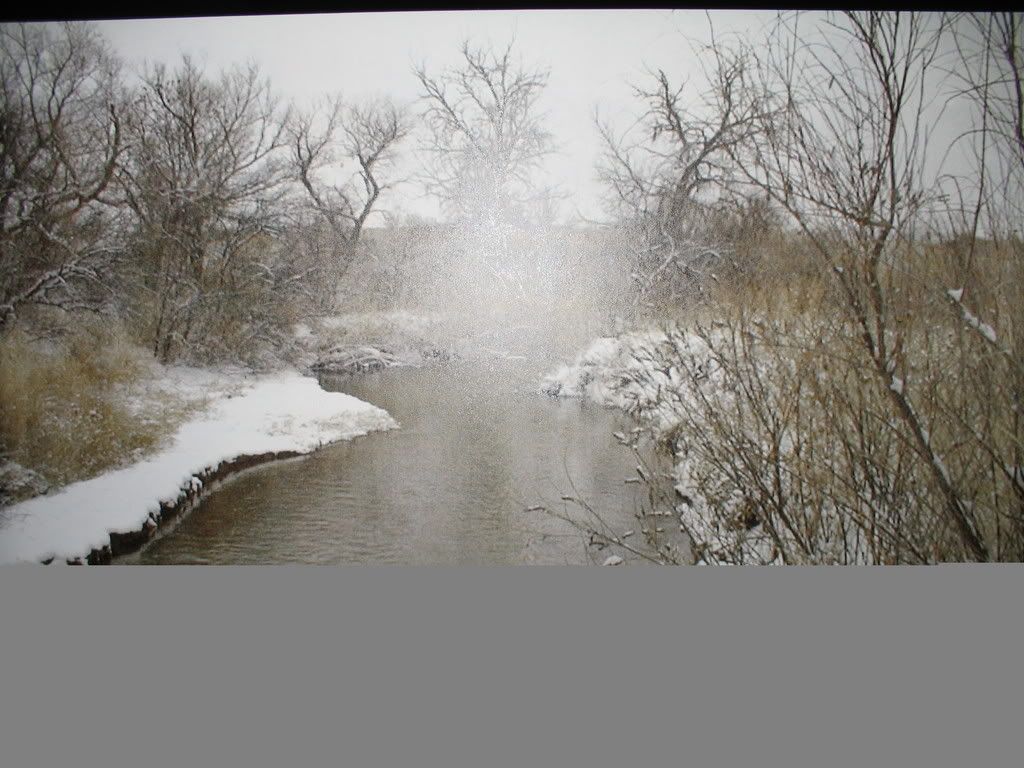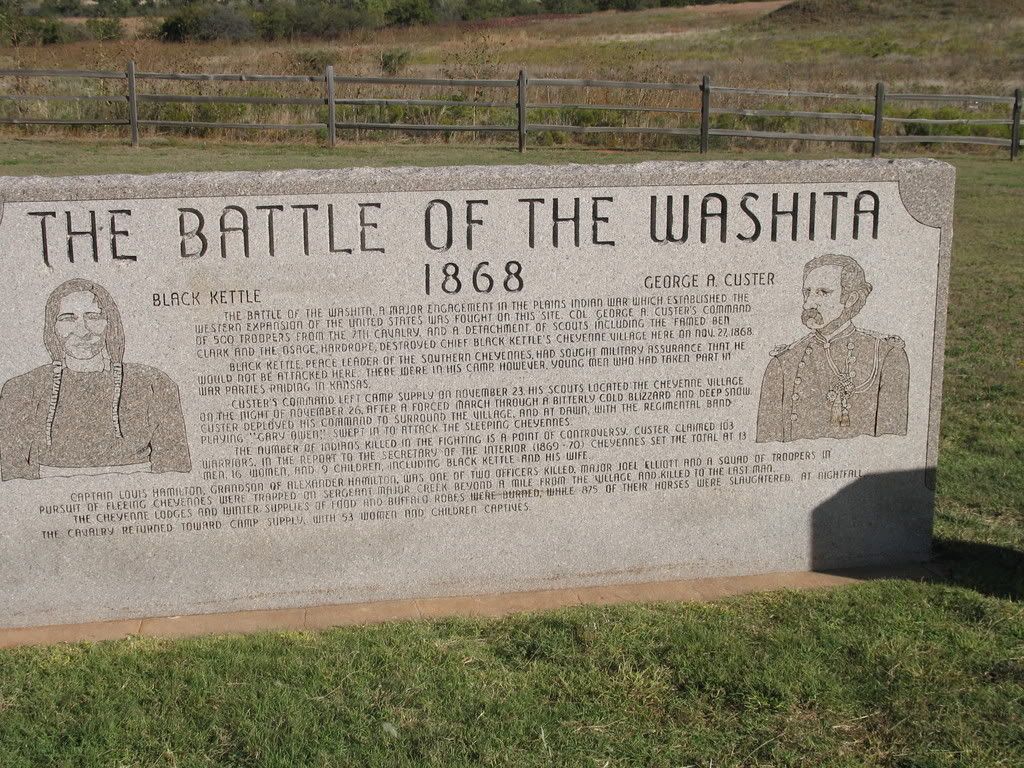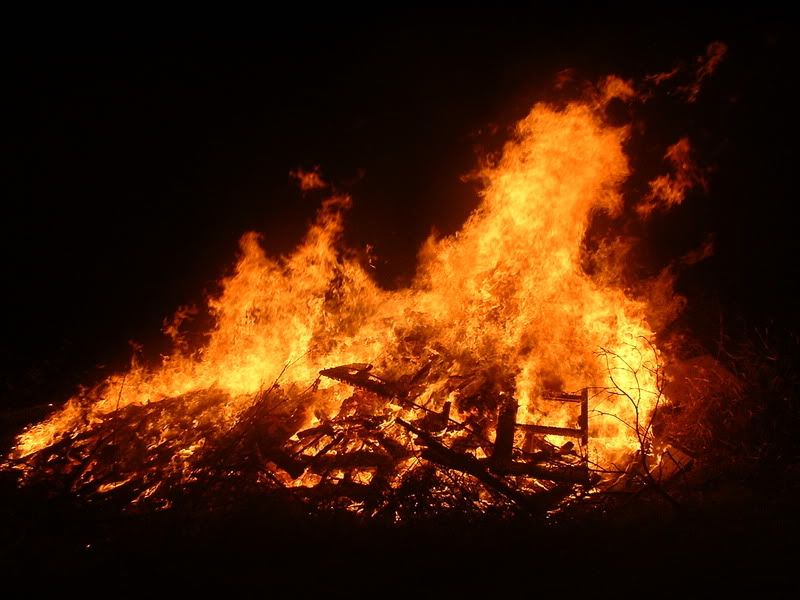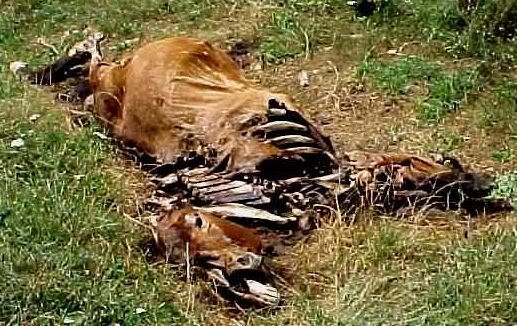(2PM EST – promoted by Nightprowlkitty)
The intent to commit genocide at Washita is hidden in plain view, unless key elements are brought together. These are: that the Cheyenne were placed on land where they would starve while promises to avert starvation were broken; that George Bent observed how Civil War soldiers did not harm white women and children by a “code of honor,” while Indian women and children were slaughtered; that Sheridan declared “The only good Indians I ever saw were dead;” and that the War Department did not differentiate between peaceful and warring Indians. Hence, the orders “to kill or hang all warriors.” As the consequence, the intent was to kill all men
of a specific race.
Crossposted at Native American Netroots
We’ll begin with Custer prior to the Washita Massacre along with the fact that the Cheyenne were forced onto land wherein they would starve.
Part 1: The Intent to Commit Genocide
Custer’s tactical errors of rushing ahead of the established military plans and dividing his troops are well known.
On the verge of what seemed to him a certain and glorious victory for both the United States and himself, Custer ordered an immediate attack on the Indian village.
Contemptuous of Indian military prowess, he split his forces into three parts to ensure that fewer Indians would escape. The attack was one the greatest fiascos of the United States Army, as thousands of Lakota, Cheyenne and Arapaho warriors forced Custer’s unit back onto a long, dusty ridge parallel to the Little Bighorn, surrounded them, and killed all 210 of them.
Yet, what enabled him to get back “on the course” after his court martial in 1867 and his being relieved by President Ulysses S. Grant temporarily in 1876?
The answers to that question are deception, wisely having prevented Washita from being labeled a massacre by halting the slaying of women and children at Washita; thus, sidestepping a full investigation as Sand Creek was (my speculation), and more lies.
Forcing and binding those Native Nations onto land where they could not survive by hunting or agriculture, breaking promises to provide those survival means, and propaganda revolving around the Kansas Raids reset Custer “on the course.” Moxtaveto (Black Kettle) was innocent.
What about the Dog Soldiers, weren’t they somehow to blame? An old Indian joke goes, “When the whites win, it’s a victory; when the Indians win, it’s a massacre.” Let’s look at what occurred amongst the Chiefs after the Sand Creek Massacre and prior to the Kansas Raids to find some answers, in between the “victories” and the “massacres.”
(Bold mine)
http://books.google.com/books?…And so, when the Chiefs gathered to decide what the people should do, Black Kettle took his usual place among them. Everyone agreed Sand Creek must be avenged. But there were questions. Why had the soldiers attacked with such viciousness? Why had they killed and mutilated women and children?
It seemed that the conflict with the whites had somehow changed. No longer was it just a war over land and buffalo. Now, the soldiers were destroying everything Cheyenne – the land, the buffalo, and the people themselves.Why? George thought he knew. He had lived among the whites and had fought in their war. He knew their greed for land and possessions – Their appetite for these things was boundless. But they also obeyed rules of warfare peculiar to them. They waged war on men, and only on recognized fields of battle. In the great life-and-death struggle between North and South even then raging in the East, prisoners were routinely paroled and released or held in guarded camps, where they were fed and cared for. And the whites never warred on women and children who were protected by law and by an unshakable code of honor –
Still Black Kettle counseled peace. A war with the whites, he said, could not be won. The newcomers were too numerous, their weapons too strong. Besides, they had the ability to fight in winter when Cheyenne horses were weak and food was scarce… For Black Kettle, Cheyenne survival depended on peace. War could only bring more Sand Creeks, more deaths, more sorrow – One by one the council Chiefs smoked the red stone war pipe, each recognizing the importance of his decision. When the pipe reached Black Kettle, he passed it on, refusing to smoke. But the others took it up, indicating they would fight.
Hence, the Kansas “Raids” were the only means left available to keep what was promised to them: the ability to survive. The land “given” to them was neither harvestable nor huntable. Those “raids” were the last resort of self defense for survival.
The Last Indian Raid in Kansas
Black Kettle miraculously escaped harm at the Sand Creek Massacre, even when he returned to rescue his seriously injured wife. And perhaps more miraculously, he continued to counsel peace when the Cheyenne attempted to strike back with isolated raids on wagon trains and nearby ranches.
By October 1865, he and other Indian leaders had arranged an uneasy truce on the plains, signing a new treaty that exchanged the Sand Creek reservation for reservations in southwestern Kansas but deprived the Cheyenne of access to most of their coveted Kansas hunting grounds.
Furthermore, General Sheridan never had any intention of peaceful relations with Black Kettle whatsoever.
(Bold mine)
Dee Brown. “Bury My Heart At Wounded Knee.” P. 169.In his official report over the “savage butchers” and “savage bands of cruel marauders,” General Sheridan rejoiced that he had “wiped out Black Kettle, a worn – out and worthless old cipher.”
He then stated that he had promised Black Kettle sanctuary if he would come into a fort before military operations began. “He refused,” Sheridan lied, “and was killed in the fight.”
In fact, it is owed to General Sheridan himself the “American aphorism,” “The only good Indian is a dead Indian.” It started as “The only good Indians I ever saw were dead.”
Whether or not Black Kettle strove for peace or the Dog Soldiers fought, they were all as “good as dead.” The extermination policy set Custer “on the course” to Washita.
(Bold mine)
Given the War Department’s mandate that all Cheyennes were guilty for the sins of the few in regard to the Kansas raids, there is no question that Custer succeeded in this purpose by attacking Black Kettle’s village. His instructions from his superiors had been “to destroy their villages and ponies; to kill or hang all warriors, and bring back all women and children.”
Part 2: The Approaching Genocide at Washita
Custer was pursuing the snow tracks of Dog Soldiers that would eventually lead to Black Kettle’s village on Thanksgiving Day in a cruel irony. The cruelest irony however, was that Black Kettle and his wife would be slain nearly four years to the day that they both escaped Chivington at the Sand Creek Massacre. Black Kettle’s honesty concerning young men in his village he could not control was of no avail. He and his village were going to be “punished” and broken beyond any immediate or distant recovery.
John Corbin, the messenger from Major Elliot, rode up and informed Custer of two large Indian snow tracks. One was recent. Preparations were then made to pursue the “savages” as covertly as possible. Smoking ceased and weapons were bound to prevent visual or aural detection. In addition, the 7th whispered and paused frequently as they rode slowly towards the future tracks that would lead to Black Kettle’s village. Simultaneously, Black Kettle received dire warnings that he and the others ignored. A Kiowa war party gave the first warning of having seen soldier’s tracks that were heading their direction. It was discounted. Black Kettle’s wife, Medicine Woman, gave another warning that night before the 7th’s arrival of an intuitive nature during the meeting in the Peace Chief’s lodge by firelight. She begged them to move immediately. It too was dismissed. They would move the next day, instead.
Black Kettle had already moved their camp recently, which the returning war party that had helped in the Kansas Raids learned upon their returning. November 25th found this war party dividing into two different directions in order to reach their destinations the quickest. Approximately 139 of them traveled to the big village on the river, while about 11 of them led Custer straight to Black Kettle. A bell around one dog’s neck enabled all the dogs to be located easily by the tribe, and after a Cheyenne baby cried, Custer pinpointed their exact location. He coordinated the attack to begin at dawn from four fronts.
Custer knew their mobility was greatly hampered in winter time; consequently, that was an important element in the “campaign.”
Part 3: The Genocide At Washita
The sensory components of the genocide at Washita in now Cheyenne, Oklahoma must be held in mind in order to capture the entire breadth of it. These are sound, smell, and sight. For example, the shrill crying of the noncombatant Cheyenne women and children, and the yelling of the charging 7th Calvary with their knives and guns would have been beyond deafening. And the fog with gunpowder smoke must have been worse than any nightmare, while the red blood – stained snow and the smell of death permeated the ground and air.
The Death & Vision of Moxtaveto ( Black Kettle)A woman dashed into the village to warn Black Kettle of the coming troopers; he hastily snatched his rifle from his lodge and fired a warning shot for all to awaken and flee. If he had attempted to meet the soldiers and ask for peaceful negotiations, that would have been useless; as a result, he then mounted his horse with his wife, Woman Here After, and tried to escape through the North direction. His horse was shot in the leg before bullets knocked him and his wife off the horse and into the Washita River, where they both died together.
“Both the chief and his wife fell at the river bank riddled with bullets,” one witness reported, “the soldiers rode right over Black Kettle and his wife and their horse as they lay dead on the ground, and their bodies were all splashed with mud by the charging soldiers.” Custer later reported that an Osage guide took Black Kettle’s scalp.
Stan Hiog. “The Peace Chiefs Of The Cheyenne.” p. 174Moving Behind, a Cheyenne Woman, later stated: “There was a sharp curve in the river where an old road – crossing used to be. Indian men used to go there to water their ponies. Here we saw the bodies of Black Kettle and his wife, lying under the water. The horse they had ridden lay dead beside them. We observed that they had tried to escape across the river when they were shot.”
Location of Black Kettle’s death

Warriors, eleven who died, rushed out of their lodges with inferior firepower to defend the village. Simultaneously, the overall noncombatants ran for their lives into the freezing Washita River.

(Taken with permission)
The words of Ben Clark, Custer’s chief of scouts, brought the truth out after Custer distributed propaganda about one white woman and two white boys as having been hostages in Black Kettle’s village. There were no “hostages, a Cheyenne woman committed suicide. Speculating, here is why.
She didn’t want her son mutilated by Custer or a 7th Calvary soldier; she didn’t want her vagina ripped out and put on a stick, worn, or made into a tobacco pouch. So, she killed her son and herself first.
Jerome A. Greene. Washita. Chap.7. pp. 130-131There, as the people fell at the hands of the troopers, one woman, in a helpless rage, stood up with her baby, held it out in an outstretched arm, and with the other drew a knife and fatally stabbed the infant – erroneously believed by the soldiers to be a white child. She then plunged the blade into her own chest in suicide.
(Location of the genocide at Washita, a few yards from Black Kettle’s death)

The 7th hunted them down and murdered them. Although the orders were to “hang all warriors;” it was much more convenient to shoot them. All wounded Cheyenne were shot where they laid.
Osage scouts mutilated women and children. They did a “roundup” of their own by using tree limbs to herd the defenseless Cheyenne women and children back to the village, where the mutilations could continue. Custer halted the slaying of women and children at one point, but he raped them later in captivity.
One Osage scout beheaded a Cheyenne.
Jerome A. Greene. Washita. Chap.7. pp120They (Osages) “shot down the women and mutilated their bodies, cutting off their arms, legs and breasts with knives.”
The 7th captured the Cheyenne and started bonfires. They burned the 51 lodges to the ground. Winter clothing that was depended upon for winter survival was incinerated in the flames, as was food supplies. Weapons and all lodge contents were burned also, including any sacred items.
Finally, 875 horses were shot, thus stripping away their last means of survival and independence.
Dee Brown. “Bury My Heart At Wounded Knee.” P.170Late in December the survivors of Black Kettle’s band began arriving at Fort Cobb –
Little Robe was now the nominal leader of the tribe, and was taken to see Sheridan he told the bearlike soldier chief that his people were starving – they had eaten all their dogs.Sheridan replied that the Cheyennes would be fed if they all came into Fort Cobb and surrendered unconditionally. “You cannot make peace now and commence killing whites again in the spring.” Sheridan added, “If you are not willing to make a complete peace, you can go back and we will fight this thing out.”
Little Robe knew there was but one answer he could give.
“It is for you to say what we have to do,” he said.
(It is worth noting also that the Fuhrer from time to time expressed admiration for the “efficiency” of the American genocide campaign against the Indians, viewing it as a forerunner for his own plans and programs.)
The Cheyenne women were “transported” by an officer named Romero to the other officers once they were prisoners at Fort Cobb.
Rape.
Custer “enjoyed one” every evening in the privacy of his tent. Presumably, he stopped raping the Cheyenne women when his wife arrived.
Custer’s wife, Elizabeth (Bacon), whom he married in 1864, lived to the age of ninety-one. The couple had no children. She was devoted to his memory, wrote three books about him, and when she died in 1933 was buried beside him at West Point. Her Tenting on the Plains (1887) presents a charming picture of their stay in Texas. Custer’s headquarters building in Austin, the Blind Asylum, located on the “Little Campus” of the University of Texas, has been restored.
Jerome A. Greene. “Washita.” Chap. 8, p.169.
Ben Clack told Walter M. Camp: many of the squaws captured at Washita were used by the officers…Romero was put in charge of them and on the march Romero would send squaws around to the officers’ tents every night. [Clark] says Custer picked out a fine looking one and had her in his tent every night.”
This statement is more or less confirmed by Frederick Benteen, who in 1896 asserted that Custer selected Monahseetah/Meotzi from among the women prisoners and cohabited with her “during the winter and spring of 1868 and ’69” until his wife arrived in the summer of 1869. Although Benteen’s assertions regarding Custer are not always to be trusted, his statements nonetheless conform entirely to those of the reliable Ben Clark and thus cannot be ignored.”
Further information regarding accurate numbers of deaths, captives and list of names are in Jerome A. Greene’s wonderful book, “Washita.”
We have been traveling through a cloud. The sky has been dark ever since the war began.
Black Kettle
Native Voices: Black Kettle
I did imagine hearing crying voices when I went to the site of the Washita Massacre and before writing Moxtaveto’s (Black Kettle’s) Extermination on November 27, 1868 & a Request. The elders say it’s haunted, like they said they could hear children cry at the Sand Creek Massacre.
To end this, I will quote former Sen. Ben Nighthorse Campbell from the dedication of the Sand Creek Massacre, “If there were any savages that day, it was not the Indian people.”





1 comments
Author
http://www.dailykos.com/story/…